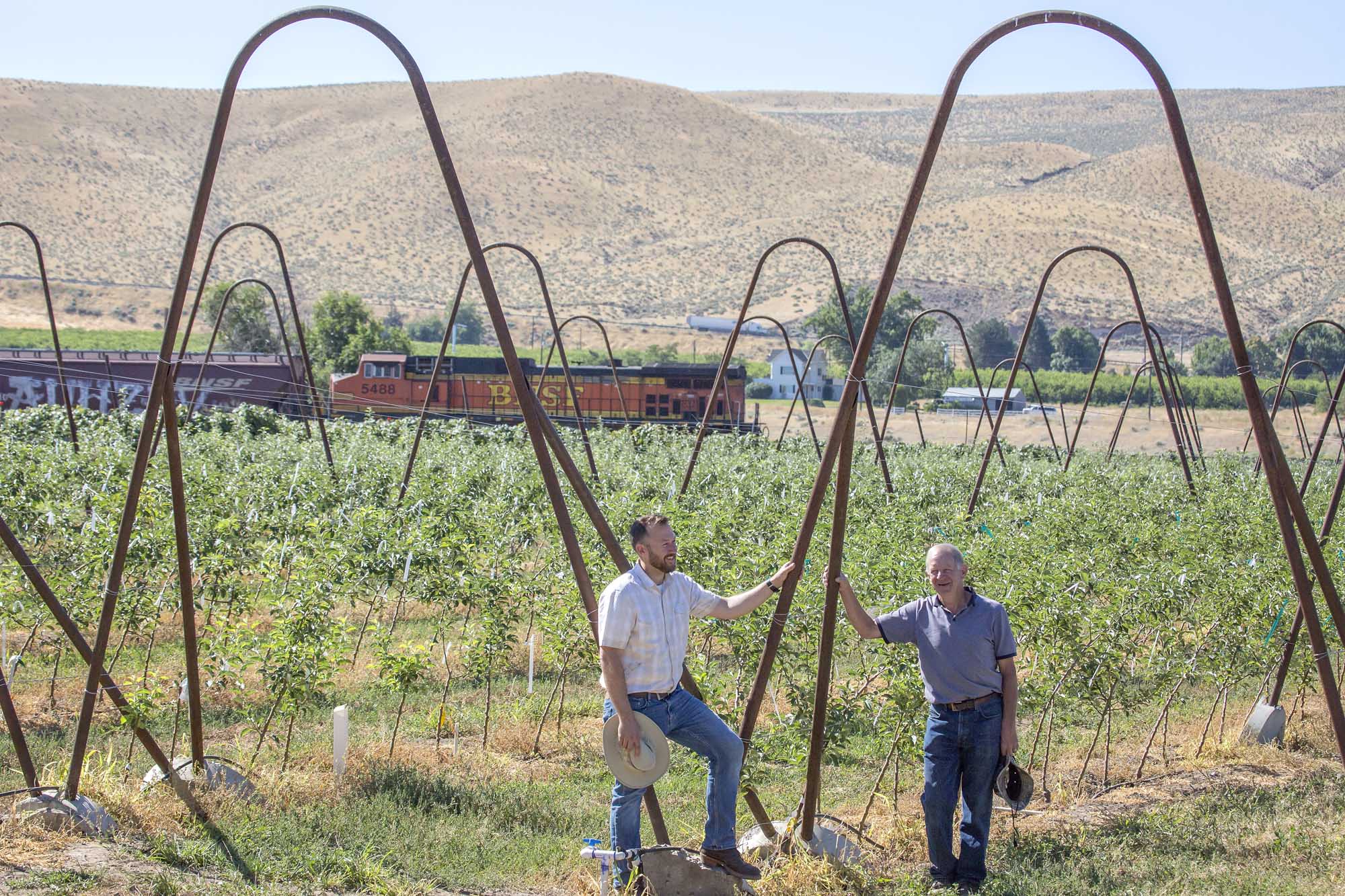
Mark De Kleine, left, shows the first commercial installation of a v-trellis system using TrellX engineered support components in Prosser, Washington, on July 11, 2017. The 1-acre block of cider apples was planted in very rocky soil that grower Bill Howell, right, said would be difficult to install a traditional wood trellis system. De Kleine said his system support rests on top of the soil using heavy steel and precast concrete supports that withstand heavy fruiting loads and high winds. (TJ Mullinax/Good Fruit Grower)
If they really wanted to, orchardists could just pick up Mark De Kleine’s new trellis and move it. The whole thing sits above ground.
De Kleine, a Prosser, Washington, agricultural engineer, has designed a trellis system of steel posts anchored into concrete footings that sit on top of the ground, eliminating the need for digging. He has two of them up in Central Washington.
His first, built in Prosser, uses bent steel pipes to form an archway over orchard alleys, anchoring into the concrete bases that push against each other, in a 1-acre block of cider apples at the home of Bill Howell, a Prosser orchardist.

The steel pipes anchor into a metal cage inside the concrete blocks. De Kleine has applied for a patent on the system. (TJ Mullinax/Good Fruit Grower)
The structure uses its own weight and Howell’s firm ground as a source of strength instead of the post depth of traditional trellises.
“You could park my bus on top of one of these hoops and it isn’t going to go anywhere,” De Kleine said.
Howell and his rocky ground offered a test opportunity for De Kleine’s invention, for which a patent is pending.
“Every time I dig a hole I end up with rock on top of the ground,” said Howell, also manager of the Northwest Nursery Improvement Institute.
No digging required
Consultants recommend post hole depth be either one-quarter or one-third the height of the post, a tall order for hard ground. “This would be useful for some rocky sites in the Hudson Valley (New York) where growers need to use dynamite,” said Mario Miranda Sazo, a Cornell Cooperative Extension fruit specialist. Neither he nor Phil Schwallier, a Michigan State University fruit extension specialist, know of above-ground trellises in their areas.
The trellises are formed by 30-foot steel pipes, each weighing 150 pounds, bent to straddle the orchard alley. Each end is slotted into a metal coupling encased in a 100-pound concrete curb, angled to match the tilt of the pipes. The weight pulls the pipes down like a staple, transferring the pressure to the concrete blocks, which are butted against each other. The more downward pressure, the stronger the whole thing gets. If they sink into wet ground, all the better.
The bent posts have no sharp points, allowing a grower to stretch netting across the top, though De Kleine recommends extra support for any additions to an existing trellis. Meanwhile, without posts in the ground, Howell was able to plant some of his UFO trees right next to the cement footers. He planted in April and installed the trellis in May.
In the windward row, De Kleine doubled the number of hoops to withstand 60-mile per hour winds and a crop load of 120 bins per acre.
One of the benefits of the above-ground trellis is that much of the engineering is already done; however, each grower will have different specifications, De Kleine said. For example, the width of the row spacing will mean different lengths of pipe and different radiuses of the bend.
De Kleine based his design on the results of his 2015 study funded by a Washington State Tree Fruit Research Commission grant. Since that project, De Kleine has started the company TrellX, the name of his new above-ground structure as well as his online trellis engineering model, TrellX.com, which also incorporates the principles of the study.
A commercial version of TrellX will be available as a kit in 2018, he said.

Mark De Kleine designed a vertical version of his above-ground trellis for Paul Booker’s Connell, Washington, orchard. (Courtesy Paul Booker)
Going vertical
De Kleine has started work on a vertical version of his above-ground trellis with client Paul Booker, a Connell, Washington, orchardist, who also owns Cider Auction, a business linking growers with cidermakers.
Booker is using the trellises on about 3 acres of cider apples planted in a UFO system. When the trees grow strong enough to support themselves in about five years or so, he plans to just move the trellis posts to a new start-up block.
Booker’s trellis is not completely above his sandy ground, however. He and De Kleine hammered 10-foot vertical steel pipes 2 feet deep into the ground through a tube through 200-pound footers that do stay on the surface. Booker, a mechanical engineer by training, wanted the extra sturdiness but suspects he could have just used wider cement footers just as easily.
Either way, he has no plans to build traditional trellises that require augers.
“We’re totally sold and we’re going to go that route from now on,” Booker said. •
—by Ross Courtney






Leave A Comment